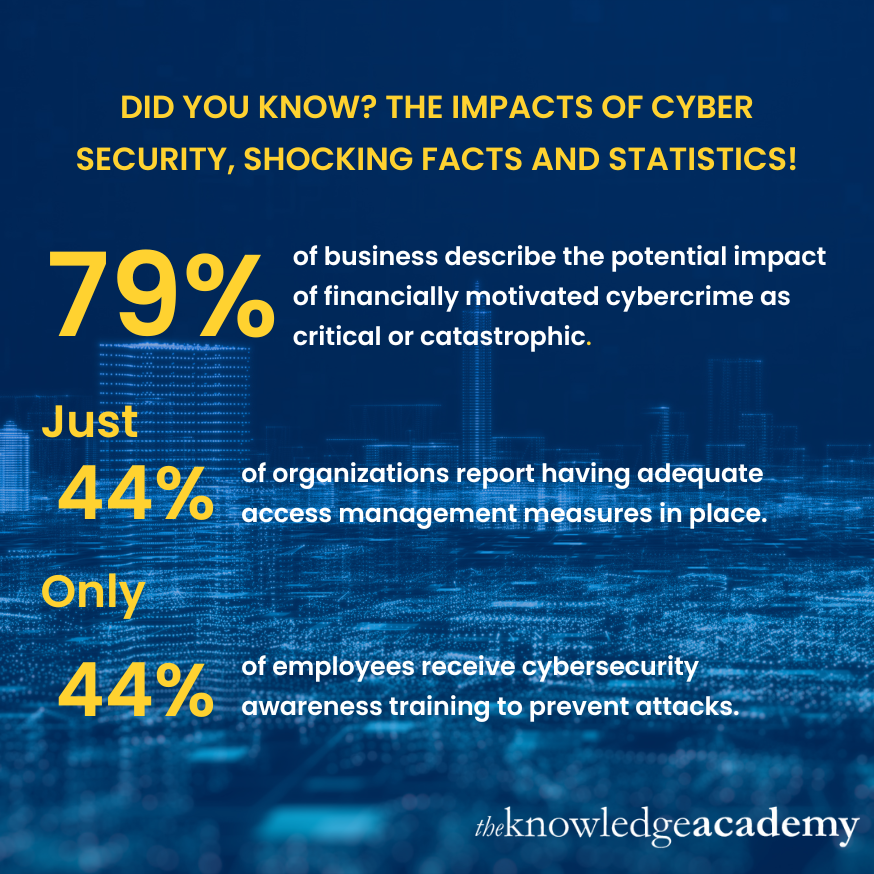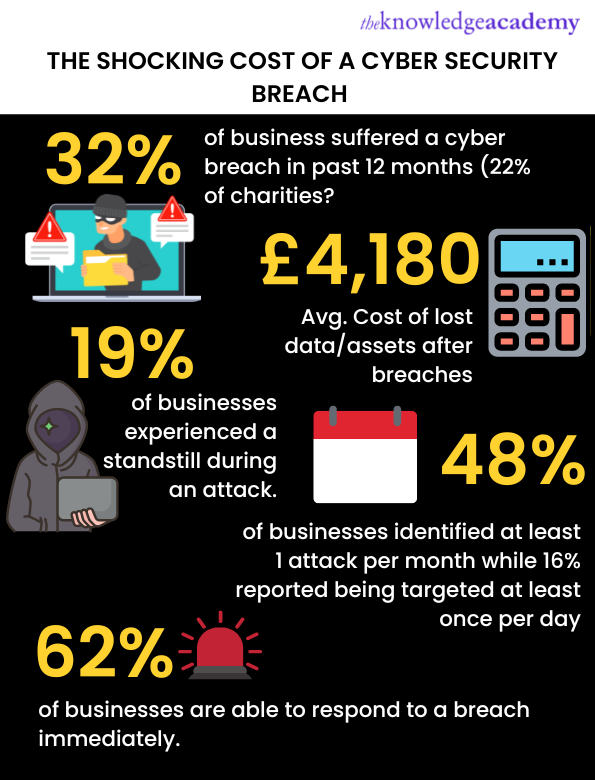We may not have the course you’re looking for. If you enquire or give us a call on +1 7204454674 and speak to our training experts, we may still be able to help with your training requirements.
Training Outcomes Within Your Budget!
We ensure quality, budget-alignment, and timely delivery by our expert instructors.

Almost every single organisation these days depends on the internet for their business. When we look at some corporate giants like Apple, Tesla, Amazon, Google, etc., the internet and technology have played a key role in their growth. With this extraordinary growth comes extraordinary threats in the forms of Cyber Security attacks and threats. In this blog, we will explain the list of top Cyber Security related facts and statistics for 2023.
According to a report by IBM, almost 95 per cent of data breaches happens due to human errors. Some of these human errors can be avoided easily, and we can reduce them with proper Cyber Security awareness. Many organisations have prioritised Cyber Security and are steadily increasing their budget to mitigate cyber-attacks impacts.
If you are looking for ways to prevent Cyber-attacks, Cyber Security analytics can help you with that since it is a proactive approach. Looking at the recent statistics on Cyber Security can help you understand how significant the problem is.
Table of Contents
1) What is Cyber Security-related facts?
2) Fun facts and figures of Cyber Security
3) Statistics of different types of Cyber Security attacks
4) Cyber Security-related facts of different industries
5) How to prevent cyber-attacks?
6) Conclusion
Check out our Cyber Security Awareness course, understand cyber threats, and learn how to prevent them!
What is Cyber Security-related facts?
Cyber Security protects digital devices like computer systems and networks in an organisation. Cyber Security Facts are the list of statistics and incidents related to Cyber Security. These statistics vary every year, and looking at these facts and statistics can help us better understand the seriousness of Cyber Security threats and can also help identify the attack patterns. An organisation can improve their security by looking at these attack patterns.
Sign up for our Cyber Security Risk Management course and gain the most valuable skills in detecting Cybercrime!
Fun facts and figures of Cyber Security

Let’s see some Cyber Security Facts and figures for the year 2023.
1) About 95 per cent of Data breaches are directly the result of human errors.
2) A study called “Daily Trends and Origin of Computer-Focused Crimes” found that at least 1 Cyber-attack happens every 39 seconds.
3) Nearly 40 per cent of the businesses in the UK have experienced an attack in the year 2023.
4) Russia has the highest Cybercrime rate, while the Netherlands has the lowest.
5) And 1 in 3 Americans suffers from at least 1 Cyber-attack every year.
6) Nearly 88 per cent of Cyber Security breaches were financially motivated, while Cyber espionage is the motivation behind at least 10 per cent of the breaches.
7) It is estimated that the cost of cybercrimes is going to cost the world about 8.4 trillion GBP annually.
8) Only about 5 per cent of an organisation’s data, like files and folders, are protected on average.
9) IBM forecasts that by 2030, quantum computers may be able to crack the technique behind Data encryption. And it could take up to a decade to upgrade the current encryption methods to prevent and ensure they are on par with quantum computers.
10) The global average cost of a data breach is 3.5 million GBP, and the average cost in the US is about 7.5 million GBP, more than double the average global cost.
11) The number of IoT (Internet of Things) devices connected to the internet will grow to 14 billion by the end of 2023, on a year-on-year basis of about 18 per cent growth. And the number of vulnerabilities for these devices grew by about 16 per cent in 2023.
12) On average, about 4 million files are stolen every day.
13) For some companies, detecting a Cyber Security breach could take up to 6 months.
14) FBI has reported that Cybercrimes have skyrocketed nearly 300 per cent after the Covid-19 pandemic.
15) In 2023 alone, there was a significant shortage of about 3.4 million skilled professionals in Cyber Security.
16) According to Cisco, 43 per cent of consumers had trouble protecting their data, and about 37 per cent switched to a different brand due to privacy concerns.
17) It is estimated that the number of DDoS (Distributed Denial of Service) attacks will grow to a whopping 15 million.
18) A study conducted by the Australian Cyber Security Centre (ACSC) found that about 2200 attacks happen daily, accounting for an attack every 40 seconds.
Fun Cyber Security Facts
1) Did you know that scammers do about 85 per cent of puppy photos posted randomly on the internet?
2) Most malicious files and extensions on the internet come in the form of MS (Microsoft) Office file formats like MS word, Excel, PowerPoint, etc.
Register for our course on Computer Forensics Foundation Training and become an expert in the field of Computer Forensics!
Statistics of different types Cyber Security attacks

Cyber-attacks vary based on their severity and complexity. Let’s see some interesting stats and facts behind these Cyber Security attacks.
Insider attacks
A former or current employee of an organisation makes insider attacks. The number of insider attacks has jumped about 44 per cent in just two years. The time it takes to detect and contain an insider attack has also increased to 85 days from 77 days.
Phishing
After the pandemic, more than 80 per cent of organisations have experienced an increase in email-based Phishing attacks. In the 40 per cent of organisations that experienced at least one cyber-attack in the UK reported that Phishing was the common threat accounting for 83 per cent of the data breach attempts.
Ransomware attacks
By 2031, it is estimated that the cost of damage from a ransomware attack may rise to 213 billion GBP. This is precisely why many organisations made Cyber Security and ransomware attacks a priority going forward.
Cyber Security-related facts of different industries
Let’s take a look into some interesting Cyber Security related facts on different industries.
Education sector
Based on “The State of Ransomware in Education in 2022” Report, organisations in the education sector don’t have Cyber insurance against Ransomware attacks. And only about 78 per cent of them have proper insurance coverage against Ransomware attacks.
Also, these educational organisations have difficulty recovering their data after a ransomware attack, and only about 2 per cent of the organisations have entirely recovered their stolen data.
Healthcare sector
Although the Healthcare sector tends to pay the least amount for ransomware attacks, it is also one of the most targeted sectors. And the number of cyber-attacks in the healthcare sector has been steadily increasing for past years and doesn’t show any signs of slowing down.
Globally, the healthcare sector's average cost of a data breach costs about 3.41 million GBP. It is about 7.43 million GBP in the US, more than double the global average. And 17 per cent of the attacks in this sector caused severe harm to the patient.
Banking sector
Cyber-attacks on the banking sector can have severe consequences and potentially collapse a nation's economy. One of the main concerns in the banking industry is phishing attacks targeting employees, as one attack could give a malicious actor access to sensitive financial data.
Around 57 per cent of the professionals in the banking industry are concerned about phishing attacks. While about 51 per cent of them are worried about phishing attacks targeting their customers. Meanwhile, 48 per cent of the employees are more concerned about ransomware attacks.
How to prevent cyber attacks?
Now that you know the severe impacts caused by Cyber Attacks, let’s focus on how to prevent such attacks in the first place. To effectively prevent Cyber Attacks and unauthorised access, organisations can use Cyber Security Analytics as a part of their strategy.
Remember, “Prevention is better than cure”, and that’s precisely what Cyber Security Analytics does. It is a proactive method that continuously monitors Cyber Security threats. When it finds any security issues, it will identify and send a detailed report on the underlying problem and provide guidelines for overcoming them.
To prevent Cyber Attacks, you should implement Cyber Security Analytics in your organisation.
Conclusion
We hope you got a clear insight into Cyber Security Facts of 2023 from reading this blog. Here we have also given you some forecasts and reports on what the future holds for the field of Cyber Security.
If Cyber Security interests you, check out our Cyber Security Training and gain expert insight into Cyber Security!
Frequently Asked Questions
Upcoming IT Security & Data Protection Resources Batches & Dates
Date
 Certified Cyber Security Professional (CCS-PRO)
Certified Cyber Security Professional (CCS-PRO)
Fri 6th Sep 2024
Fri 20th Dec 2024







 Top Rated Course
Top Rated Course




 If you wish to make any changes to your course, please
If you wish to make any changes to your course, please


